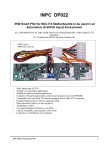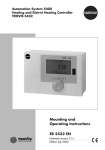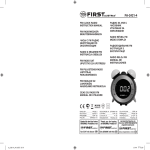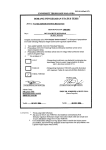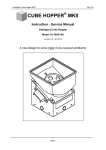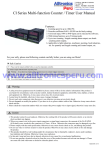Download User manual - DV Industrial Computer
Transcript
INPC DP024 90W Smart PSU for Mini-ITX Motherboards to be used in an Automotive (19-35Volt Input) Environment ALL INFORMATION IN THIS USER MANUAL IS PRELIMINARY AND SUBJECT TO CHANGE. R 0.02 December 2008 DV Industrial Computer Ltd. • • • • • • • • • • • • Wide input range (19-35V) Suitable for automotive applications Suitable for battery powered applications Complete with start-up/shut-down control (user adjusted, saved in EEPROM) Compatible with most Mini-ITX boards equipped with a 20pin ATX connector Possibility to control by two standard 12V cooling fans (3-pin) Realizes a thermostat by driving heater at temperature lower than 0°C Silent operation (fanless) Temperature control Low heat dissipation (efficiency over 85%) Chassis mountable, measurements: 34x170x24 Connection via COM-port with computer Notice This device should be attached and tuned by specialized personnel only after familiarizing with current manual! Please take a moment and read this manual before you install the DP024 in your vehicle. Often rushing into installing the unit can result in serious damage to your DP024 converter, computer and probably your car electrical system. The DP024 converter has several wires that need to be installed in various places. When installing, always double check the polarity of your wires with a voltmeter and by sight. INPC DP024 Automotive PSU 1 Introduction This manual is intended for firmware release 0.02. The firmware release number is written on the label stick on the MCU inside the device and also this number can be obtained by a proper command sent through the serial line. All registered trademarks are the property of their respective owners. Overview The DP024 is a fully compliant ATX power supply designed to power a low power system from a single 24V power source. The DP024 power supply has an MCU that controls and monitors various functions of the power supply operation. Also, it realizes voltages monitoring, temperature monitoring and communication via COM-port with computer. As well the MCU realizes a WatchDog timer to supervise the computer. A LED indicator in the power supply continually Battery RS232 (COM) reports the power system status and health. It 19..35V Fan1 Fan2 is also used for troubleshooting. - + Ignition Notwithstanding the fact that the DP024 can GND t° PowerOn operate without active cooling it realizes a Button hardware-firmware device for a temperaturebased automatic-fanspeed control of two fans. Reducing of the fan speed as the temperature Buck/Boost DP024 drops minimizes the system acoustic noise converters prolongs fans service life period, diminishes and AT X MCU power consuption. The use of two fans that has power logic OUT P UT S: been controlled by DP024 allows to build a LED +5Vsb, +5V, system with redundant cooling facilities and +3.3V, +12V, -12V allows to design fault-tolerant system with long-life performance. For operating at low temperature the DP024 can act as thermostat with heating. There are four main working ON/OFF RESET states of the DP024 - Deep Sleep, Sleep, 20pin AT X connector switch switch Standby, Power On. The DP024 has user selectable MCU driven timing settings, Motherboard allowing you to choose various ignition/shutdown vehicle computer timing schemes (settings). These settings are user adjusted and saved in EEPROM. These settings allow to overcome the main problems of vehicle computer power supplying. One of most difficult tasks of operating a computer in a vehicle is power consumption while the computer is OFF. Even if your computer is totally OFF (Standby state), a computer will still consume a few hundred milliwatts, needed to monitor computer ON/OFF status. All power supplies provide 5Vsb (5V standby) so that the motherboard can issue at least a PSON signal. When the computer is in the suspend/sleep mode, it will consume even more power, because the RAM needs to be powered at all times. The power consumption in the suspend mode is few Watts. No matter how big your car battery is, it will eventually drain your vehicle battery in a matter of days. The DP024 is addressing these issues by cutting off the 5VSB rail after a pre-defined amount of time (timing settings). The DP024 monitors battery voltage to protect against deep discharge. When battery level drops below predefined value for more than predefined time, the DP024 will shut down and re-activate only INPC DP024 Automotive PSU 2 when the input voltage is > predefined value. Of course, there is a traditional PC PSU mode setting with no ignition control (shutdown logic bypassed) and it can be used in non-vehicle computer applications. Input Characteristics Minimum Input Operating voltage 9V (8,5V for less than 0.01sec ) Maximum Input Operating voltage 25V (30V for less than 0.01sec) Maximum Input Current (Sleep Mode) 20mA Maximum Input Current (Deep Sleep Mode) 5mA Range of Adjustable Lower Voltage Threshold 9~15V Output Power Characteristics Output Connector ATX Power 20 pin (Molex P/N 39-01-2200) Output Rail Maximum Power (at 27V Input – engine is running) Current (Max) Current Peak Regulation (<5 seconds) 5Vsb 6A* 8A* 3% 5V 6A* 8A* 3% 3.3V 6A 8A 3% 12V 4A 5A 3% 0.15A 10% -12V 0.1A *Total current on 5Vsb and 5V rails Output Rail Maximum Power (at 25V Input – engine is off) Current (Max) Current Peak Regulation (<5 seconds) 5Vsb 6A* 7A* 4% 5V 6A* 7A* 4% 3.3V 6A 7A 4% 12V 4A 4.5A 4% 0.15A 10% -12V 0.1A *Total current on 5Vsb and 5V rails INPC DP024 Automotive PSU 3 Output Rail Maximum Power (at 20V Input – engine cranks or deep discharge) Current (Max) Current Peak Regulation (<5 seconds) 5Vsb 5A* 6A* 5% 5V 5A* 6A* 5% 3.3V 5A 6A 5% 12V 3.5A 4.0A 5% -12V 0.1A *Total current on 5Vsb and 5V rails 0.15A 10% Connection NOTICE! Do not connect a Car Battery Charger directly to the DP024. The DP024 has several wires that need to be installed in various places. When installing, always double check the polarity of your wires with a voltmeter. NEVER use the cigarette plug as a power source; often the contacts are not capable of delivering high current to your PC. AT FIRST! Connect a 2-pin jumper cable between JP2 and the motherboards "Reset" header. This will allow the DP024 to reset the motherboard by simulating a reset button press (POLARITY MATTERS HERE). Connect a 2-pin jumper cable between JP3 and the motherboards "Power On" header. This will allow the DP024 to turn on and off the motherboard by simulating a power button press (POLARITY MATTERS HERE). JP6 is a 10-pin polarized connector that is used for connection via serial line (RS-232) to the COMport of the computer. The DP024 uses the RTS/CTS hardware handshaking of serial line flow control. However, the DP024 ignores signal on RTS line assuming that control computer is always ready to receive data. Therefore, really only four-wire link is required – SG (Signal Ground), SIN(RD) (Serial Input/Read of data), SOUT(TR) (Serial Output/Transmit of data), CTS( Clear To Send). Connect a 10-pin flat ribbon cable to COM port connector of your control computer. RT1 (2-pin connector) is used to connect remote (0.4m) temperature sensor (thermistor). Place remote thermistor at CPU heatsink of your computer. Connect the ATX Power Connector JP8 to the motherboard and any peripherals to JP9 connector. INPC DP024 Automotive PSU 4 INPC DP024 Automotive PSU 5 AT THE END! Connect the “ground”, IGNITION+ and 24 Volt supply (JP1). One should to fully appreciate the function of the IGNITION+ signal (pin 2). At the moment immediately after 24V supply voltage was applied (a battery was connected) the DP024 analyses the value of this signal. If the IGNITION+ signal is lower than 0.5V then the DP024 will switch to the “VEHICLE MODE”. Else, if the IGNITION+ signal is higher than 3V at the moment when the supply voltage was applied the DP024 will switch to the “DUMB MODE”. You should eliminate the situation when this voltage is between 0.5~3V (as not defined) because the DP024 will define mode not stable. The DP024 has build-in pull-up of the IGNITION+ signal therefore in order to switch to the “DUMB MODE” you may leave the IGNITION+ signal free and do not connect it at the moment when the supply voltage is being applied. And vice versa, in order to switch to the “VEHICLE MODE” you must keep the IGNITION+ signal closed to the “ground” or GND (pin 3 of JP1) or provide the IGNITION+ signal voltage level less than 0.5V by corresponding current load at the moment when the supply voltage is being applied. One should to fully appreciate the fact that the DP024 can define its further mode of operation SOLELY AT THE MOMENT when the supply voltage is being applied and can be switched from the mode to mode by taking off and second applying the supply voltage with prior the IGNITION+ signal change. Later, while it is working, the DP024 analyses the “ignition” line of vehicle and controls switching on/off logic and powering of the motherboard only if is switched to the “VEHICLE MODE”. If the DP024 has been switched to the “DUMB MODE” when the supply voltage is being applied then the “ignition” line has the same action as the “POWER” button because this line is paralleled for analyse to the “POWER” button. If the “Ignition Key” is opened then it is the same that the “POWER” button is pressed but if the “Ignition Key” is closed then it is the same that the “POWER” button is released. The DP024 can be tested in the lab before being installed into the vehicle. The picture shown below explains how to do it and is in use for testing and reseach of the DP024. Certain details need to be noted for proper bench testing. When connecting bench power use between 24 to 32 Volts DC to POWER (+) and GND (BATTERY) (-) terminals for best results. The best way to do successful bench testing is to use an adequately sized 24V battery. Bringing in the battery from the car or using an extra one that has at least a 10-AmpHour capacity will be sufficient in most cases. To aid in bench testing, it is enough do not connect IGNITION+ anywhere. The DP024 will operate as “dumb PSU” with button “POWER” control. Ri resistor (10k) simulate load in the “ignition” line of vehicle. Because of this resistor the voltage value will less than 0.5V if the “Ignition Key” is released. INPC DP024 Automotive PSU 6 In order to connect to 24V vehicle circuit the first you should connect the GND line of the JP1 connector directly to the automotive batteries (–) terminal with heavy gauge wire. GND may also be connected with vehicle chassis if desired. Then connect the IGNITION+ (pin 2 of JP12) to the switched +24 Volt supply wire (“ignition” circuit or fuse box). This will bypass the Startup/Shutdown sequence and battery protection. At the end connect POWER line of JP1 connector directly to the automotive batteries (+) terminal with heavy gauge wire. Apply 24 Volts to IGNITION+ by turning on the ignition or by flipping a switch and you’re ready to go! Do not connect IGNITION+ anywhere if you use the DP024 as a non-vehicle PSU. In this case the DP024 will operate as “dumb PSU”. Operation “VEHICLE MODE” If ignition is OFF and the IGNITION+ signal is LOW (about 0 Volts), then nothing happens and the DP024 stays in Sleep state (LED Blinks as 0.03sec On / 1sec Off). The DP024 is waiting for “ignition” signal. The user steps into the automobile and turns on the key. IGNITION+ goes HI (24Volts) and as a result the DP024 wakes up from Sleep Mode. The DP024 waits for 4 seconds, then turns on the 5Vsb rail. After another second the DP024 sends an “ON” signal to the motherboard via the 2 wires connected to the JP3 and to the motherboard’s “Power On” header. The motherboard will turn ON and your system should start booting. Ignition is ON during driving. Your computer will remain ON playing MP3s, doing GPS Navigation, etc. The automobile goes to the gas station and the driver turns off the key and IGNITION+ goes LOW. The DP024 now starts the Countdown Timer T1. The driver gets back in the car, starts the car and the computer keeps playing the MP3s without a hiccup. The user then drives home and turns off the car for the night. IGNITION+ goes low and the Countdown Timer T1 starts. The DP024 waits for “STANDBYDELAY” - then Countdown Timer T1 expires. The DP024 then sends a pulse again over JP3 pins to shutdown the computer. The shutdown pulse was successful and the computer turned off (Standby state). The Countdown Timer T2 starts. The DP024 waits for “SLEEPDELAY” - then Countdown Timer T2 expires. The DP024 then goes to Sleep state and preserves battery power. While in Deep Sleep or Sleep state, the DP024 constantly monitors your car battery voltage levels, preventing deep discharge situations by automatically shutting down until battery levels reach safe levels again. “DUMB MODE” The DP024 behaves as a regular ATX PSU with button “Power On/Off”. Of course, the DP024 monitors battery voltage to protect against deep discharge and monitors temperature and outputs. You can monitor these parameters via serial line in “DUMB MODE” as well as in “VEHICLE MODE”. Also, the WatchDog timer can be used. So, it seems that the DP024 is not a regular ATX PSU. INPC DP024 Automotive PSU 7 DP024 & LED Status Codes Dumb Mode Vehicle Mode PSU State LED Status Deep Sleep Blink every 2s (0.03s ON) / (2s OFF) Sleep Blink every 2s (0.03s ON) / (2s OFF) StandBy Blink every 1s (0.03s ON) / (1s OFF) PowerOn Blink every 1s (1s ON) / (0.03s OFF) Sleep Over Temperature Blink every 4s (0.03s ON) / (4s OFF) Sleep PSU Overload or Fault Blink every 4s (0.03s ON) / (4s OFF) Deep Sleep Double Blink every 2s (2x0.03s ON) / (2s OFF) Sleep Double Blink every 2s (2x0.03s ON) / (2s OFF) StandBy Double Blink every 1s (2x0.03s ON) / (1s OFF) PowerOn ON Sleep Over Temperature Double Blink every 4s (2x0.03s ON) / (4s OFF) Sleep PSU Overload or Fault Double Blink every 4s (2x0.03s ON) / (4s OFF) Serial Line (RS232) Notice! The DP024 PSU operates completely independent of computer's software and serial line connection. The DP024 that is connected to control computer by serial line, operates as a terminal device with fixed connection 9600, 8 bit, no parity, 1 stop bit. Usually, computer acts as initiator of data communication – the host. The computer can send commands and data to the DP024. The DP024 responds by data block to the most commands sent from computer. The DP024 realizes a likeness of ANSI/VT100 terminal by means of subset of commands with extensions for WatchDog timer, temperature and voltage measurement channel and so on. Input from serial line is latched by incoming buffer of 23 byte size. String with 24 bytes and more will be wrapped. The DP024 starts parsing after receiving of CR(0x0d) or LF(0x0a) symbol or after overflowing of input buffer (23 bytes). Note that parameters, such as timeout for the WatchDog timer, are in ASCII digits, so 12 is represented by the characters “1” and “2”, not by a single byte with the value of 12. Also, characters are case sensitive, so /W and /w are two different commands. INPC DP024 Automotive PSU 8 WatchDog timer The WatchDog timer is designed to overpass a computer hanging up. Usually computer almost never hangs up. However, if it hangs up and gets stuck, usually there is nobody at the site to press the reset or nobody knows where the stuck computer is because there were no problem with it for a long time. The WatchDog timer is used just for such situations. It automatically restarts the computer that is hung up. To restart computer, the WatchDog timer closes circuit between pins 1 and 2 of JP2 connector. The WatchDog timer is off after starting of the DP024. To switch it on, the command “/WW” should be sent and timeout (number of ticks, one tick is 0.3 seconds) should be set by indicating required W, which is a value between 0 and 255. The driver program needs to set the timeout periodically to avoid the WatchDog hits and following “reset” contacts closing. Detailed information about WatchDog is given in the further sections. Fan Control Notice! The DP024 PSU drives attached fans from its own +12V output rail. Therefore, the attached fans can be run only when the DP024 turns on the +12V rail (PowerOn state). The principle of controller operation is frequent measuring (3 times per second) and analysing of airflow temperature and rotation speed of attached fans as well as generating of the voltage applied to the fan according to preliminary charted matrix. A typical 12VDC fan has an effective operatingvoltage range of about 7 to 12V. The lowest voltage at which the fan will operate is about 5 to 7V, but this may be the lowest voltage at which the fan will run once already spinning. The DP024 varies this voltage by step-down converter with pulse width modulation (PWM) to realize linear control. Up to 4 fans with nominal voltage 12VDC and with three wires (third wire is the fan's tachometer signal) could be attached to the controller. The DP024 can detect the quantity of attached fans by means of own special procedure that will be described further. The range of measured temperature from 18 to 60ОC is quantized by 3ОC intervals. Each interval is associated with PWM value of step-down converter. The value of PWM that is associated with temperature interval could be changed and regulation curve could be mould individually. The content of such matrix with pre-charted by producer default values is given below: ТоС <18 <21 <24 <27 <30 <33 <36 <39 <42 <45 <48 <51 <54 <57 <60 PWM% 45 45 45 45 50 55 60 65 70 75 80 85 90 95 100 INPC DP024 Automotive PSU 9 The figure below that explains fan control shows how the measured value of temperature (36°C) addresses the row of matrix with PWM 60%. PWM value determines fan voltage and finally POWER +12V the rotation speed. Measured values are t°C PWM% compared with tabulated 60 100 points (individually for each fan). Normally 65 39 functioning fan should PWM VOLTAGE 60 36 REGULATOR not have the rotation 55 33 speeds lower than threshold matrix values. 18 45 In presented example the measured value of temperature (36°C) and PWM value 60% determine the threshold VAR. +5~12V rotation values for 1st and PWM TO THRESHOLD 2nd fan as 1400 and 2200, RPM MATRIX correspondingly. Even if one of fans has rotation Fan1 speed lower than preRPM PWM% charted threshold value, 1400 the DP024 detects it as a 60 2200 fault and defines PWM Fan2 1300 100%. Thus, early 55 2000 diagnostics of fan failure is assured at the time when rotation (and cooling) ability still is not lost but fault has been detected and signalized. If quantity of fans and air performance are redundant, the early diagnostics allows to increase reliability of cooling system essentially, while fan speed-down at low temperature increases fan life and decreases acoustic noise of the most unreliable and noisy element of modern electronics – fan. Both tables of matrixes are placed in nonvolatile memory and there are some ways for their corrections if needed. The controller (matrix) can be tuned up to determine individual handling characteristic both for PWM temperature characteristic and for attached fan behaviour in real use environment. TEMPERATURE TO PWM MATRIX TRANSDUCER ... ... ... ... INPC DP024 Automotive PSU 10 Using the serial line of the DP022 in MS Windows (MS Windows XP for example) Assume that computer has available COM3 port that should be set as 9600, 8 bit, no parity, 1 stop bit operation. As a dialog application let us use Hyper Terminal that is included in MS Windows. To get it ready, open the folder Communications and run Hyper Terminal (click on “Start” button and then Programs - Accessories – Communications. The dialog window appears on the screen. Let us name our connection as PSU (arbitrary name) : Then, select connection via serial port COM3 in Connect To dialog window: INPC DP024 Automotive PSU 11 And set up COM3 properties: Click on File button in main menu of Hyper Terminal program and click on item Properties in pop up menu. In dialog window PSU Properties select bookmark Settings and select the following properties: INPC DP024 Automotive PSU 12 When Hyper Terminal configuration has been finished, everything is ready to dialog with the DP024. Commands that are entered on terminal keyboard are sent to the DP024 via serial port while input data flow is displayed on terminal window. In the clear terminal window enter the first command h (help) – press keys h and then Enter. As a response the controller sends firmware release number and list of commands that are supported: If you see this list, all settings have been made correct and you can continue with study of commands. The commands have friendly interface to interact with terminal program. NOTICE! The commands that start with symbol “/” (slash) are focused to be used with dedicated programs (of course, you can use them with terminal program). Some of commands answer with asked value, but some of commands do not. All answers that have started with symbol “/” are tailed with symbol “/”, carriage return, line feed and prompt symbol “>” - a (display all) Press two keys a and Enter. As a response, the DP024 sends current value of temperature, output voltages, input voltage, value of Trip Threshold Low Voltage, contents and initial values of Timers T1 and T2, current state of operating, fan revolution values and so on for the moment when the command has been sent. INPC DP024 Automotive PSU 13 /b (get “STANDBYDELAY”) Press three keys / b and Enter. As a response, the DP024 sends current value of “STANDBYDELAY” – initial value for T1 timer (in seconds). This value should be loaded into counter of T1 timer when IGNITION+ goes low. After that T1 timer starts time countdown. The DP024 switches to StandBy state when T1 timer expires. The “STANDBYDELAY” value has been saved in EEPROM. /B (set new value of “STANDBYDELAY”) Press keys / B and then type value of seconds from 0 to 255 and finish with Enter. You can check accuracy of setting by /b command (get “STANDBYDELAY”). If you set “STANDBYDELAY” to 0, then the DP024 will switch to StandBy state immediately after circuit IGNITION+ has gone low. /cb (get counter value of T1 timer”) Press four keys / c b and Enter. As a response, the DP024 sends current value of T1 timer counter (in seconds). At the moment when IGNITION+ goes low while the DP024 is being in PowerOn state - T1 timer starts decrementing (counter value count down). Therefore, second command that can be sent with delay of some time will result in another value with difference that corresponds to delay from first command point. /cs (get counter value of T2 timer”) Press four keys / c s and Enter. As a response, the DP024 sends current value of T2 timer counter (in seconds). At the moment when the DP024 switches into StandBy state T2 timer starts decrementing (counter value count down). Therefore, second command that can be sent with delay of some time will result in another value with difference that corresponds to delay from first command point. /e (get “SLEEPDELAY”) Press three keys / e and Enter. As a response, the DP024 sends current value of “SLEEPDELAY”, initial value for T2 timer (in seconds). This value should be loaded into counter of T2 timer when the DP024 switches into StandBy state. After that T2 timer starts time countdown. The DP024 switches to Sleep state when T2 timer expires. The “SLEEPDELAY” value is being stored in EEPROM. /E (set new value of “SLEEPDELAY”) Press two keys / E and then type value of seconds from 0 to 255 at finish with Enter. You can check accuracy of setting by /e command (get “SLEEPDELAY”). If you set “SLEEPDELAY” to 0 then the DP024 will switch to StandBy state at no time. INPC DP024 Automotive PSU 14 /f (get “CONFIGURATION”) Press three keys / f and Enter. As a response, the DP024 sends current value of “CONFIGURATION” – either 0 or 1. If the value is 1, then the DP024 is configured for restart in case of recovery after a special kind of errors – revised. The first of revised errors is - overheating – the error that appears when even one of two thermistor will reach 65 ОC but disappears when both thermistors will be below 55ОC. The second error is – input voltage is lower than Low Voltage Threshold - the error that appears when input (battery) voltage will drop lower than Low Voltage Threshold but disappears when input voltage will rise above Low Voltage Threshold value more than value of Voltage Threshold Hysteresis. The “CONFIGURATION” value has been saved in EEPROM. /F (set new value of “CONFIGURATION”) Press two keys / F and then type value of either 0 or 1 at finish with Enter. You can check accuracy of setting by /f command (get “CONFIGURATION”). If you set “CONFIGURATION” to 0 then the DP024 will not restart after recovery and will stay in one of the following states: Sleep Over Temperature/ PSU Overload or Fault till the input voltage is off even over temperature or low input voltage error has been recovered. /gl (get Trip Threshold Low Voltage) Press four keys / g l and Enter. As a response the DP024 sends value of Low Voltage Threshold (in millivolts). The DP024 switches into Sleep PSU Overload or Fault state if input voltage does not exceed Low Voltage Threshold. The Low Voltage Threshold value is being stored in EEPROM. /Gl (set new value of Trip Threshold Low Voltage) Press keys / G l and then type value of millivolts from 18000 to 29000 and finish with Enter. You can check accuracy of setting by /gl command (get Lower Voltage Threshold). /gh (get Trip Threshold Low Voltage Hysteresis) Press four keys / g h and Enter. As a response the DP024 sends value of Voltage Threshold Hysteresis (in millivolts). In case if the DP024 has been switched to Sleep PSU Overload or Fault state (and this error was caused by dropping of input voltage below Low Voltage Threshold value) and if the input voltage stays less than sum of Low Voltage Threshold and Voltage Threshold Hysteresis, the DP024 will stay in Sleep PSU Overload or Fault state. If input voltage rises over sum of Trip Threshold Low Voltage and Trip Threshold Low Voltage Hysteresis, the DP024 will switch into StandBy state. The Trip Threshold Low Voltage Hysteresis value is being stored in EEPROM. /Gh (set new value of Trip Threshold Low Voltage Hysteresis) Press keys / G h and then type value of millivolts from 500 to 5000 and finish with Enter. You can check accuracy of setting by /gh command (get Trip Threshold Low Voltage Hysteresis). h (get list of commands) Press two keys h and Enter. As a response, the DP024 sends firmware release number and list of commands. INPC DP024 Automotive PSU 15 /m (get current Value of Rotation Speed for both Fans) Press three keys / m and Enter. As a response, the DP024 sends two values of rotation speed (revolutions per minute – RPM) that have been measured for both fans and are separated by “/” symbol (slash). First value is for the first fan and second – for the second fan. You can control RPMs for both fans on-the-fly by sending this command periodically. /n (get firmware release number) Press three keys / n and Enter. As a response, the DP024 sends firmware release number. /p@T (get table Value of PWM for indicated temperature) PWM value for indicated temperature interval T (allowed value from 18ОC to 60ОC) should be read from EEPROM and sent to the computer. The DP024 makes quantization of parameter T if needed. The value of T should be quantized to the nearest smallest integer value down to 3 ОC. For example, /p@20 command returns matrix value of PWM for temperature interval 18 ОC (20 is quantized to 18). /P@T=P (set new table Value of PWM for indicated temperature) New table value of PWM = P (allowed value is either 0% or value from 40% to 100%) for indicated temperature interval T (allowed value from 18 to 60ОC) should be saved EEPROM matrix. The DP024 makes quantization of parameters if needed. The value of P should be quantized to the nearest smallest integer value down to 5%. The value of T should be quantized to the nearest smallest integer value down to 3ОC. For example, /P@38=63 command assigns new PWM value 60% (63 is quantized to 60) for temperature interval 36ОC (38 is quantized to 36). /r@P (get table Value of threshold RPM for indicated PWM) Matrix values of threshold rotation speed (RPM - revolutions per minute) for both fans and for indicated value of pulse width modulation PWM = P (allowed value of PWM from 40% to 100%) should be read from EEPROM and sent to the computer. The DP024 makes quantization of parameter P if needed. The value of P should be quantized to the nearest smallest integer value down to 5%. For example, /r@99 command returns matrix values of threshold RPM for PWM 95% (99 is quantized to 95). The values of RPM are separeted by “/” symbol (slash) /RF@P=R (set new table Value of threshold RPM for indicated Fan and PWM) New table value of threshold rotation speed R (revolutions per minute RPM – 0~25000) of fan F (allowed value either 1 or 2) for indicated value of pulse width modulation (allowed value of PWM from 40% to 100%) should be saved in EEPROM matrix. The DP024 makes quantization of parameters if needed. The value of R should be quantized to the nearest smallest integer value down to 100rpm. The value of P should be quantized to the nearest smallest integer value down to 5%. For example, /R2@42=1055 command fixes new threshold value 1000rpm (1055 is quantized to 1000) for fan 2 for PWM 40% (42 is quantized to 40). INPC DP024 Automotive PSU 16 /s (get current state) Press three keys / s and Enter. As a response the DP024 sends numeric value that corresponds to current state. The correspondence table looks as following: Value Status Explanation 0 PowerOn Switched on, all rails have been activated. 2 StandBy Switched off, only 5Vsb rail has been activated. 6 Sleep Switched off, any rail has not been activated. 7 Deep Sleep Switched off, any rail has not been activated. 8 Sleep Over Temperature Switched off, any rail has not been activated. 9 Sleep PSU Overload or Fault Switched off, any rail has not been activated. /t (get current value of temperature) Press three keys / t and Enter. As a response, the DP024 sends two values of temperature that aree separeted by “/” symbol (slash). First value is measured by remote thermistor, second is measured by internal DP024 thermistor. You can control temperature on-the-fly by sending this comand periodically. /u (get “STARTUPDELAY”) Press three keys / u and Enter. As a response, the DP024 sends current value of “STARTUPDELAY”, value of delay for startup timer (in seconds) that the DP024 make as pause after input voltage 12V has been applied. The “STARTUPDELAY” value is being stored in EEPROM. /U (set new value of “STARTUPDELAY”) Press two keys / F and then type value of seconds from 0 to 255 at finish with Enter. You can check accuracy of setting by /u command (get “STARTUPDELAY”). /v (get current values of input and output voltages) Press three keys / v and Enter. As a response, the DP022 sends five values of voltages that are separated by “/” symbol (slash). First value is input voltage (nominal value is 13.5V), second value is 5Vsb, third - 12V, fourth - 5V and fifth - 3,3V. Values have sent in millivolts. You can control voltages on-the-fly by sending this comand periodically. /w (get current value of counter of WatchDog timer) Press two keys w and Enter. As a response, the DP024 sends current value of counter of WatchDog timer (in ticks, each tick is 0.3s long). /W (set current value of counter of WatchDog timer) Press two keys / W and then type the value of ticks from 0 to 255 (each tick is 0.3s long) and finish with Enter. As a response, the DP024 sends “/” symbol (slash) and just entered value which allows to check accuracy of setting. INPC DP024 Automotive PSU 17 x (Connected Fan Examination Procedure Activation) When, the fan examination procedure starts, the DP024 varies PWM value from 100% to 40% with 5% step and varies testing voltage from max to min values every 3sec. The procedure starts with 100% value of PWM. Later, the rest of 12 values of PWM from 95% to 40% are proceeded. Outcome of procedure is the update of fan threshold revolution matrix for really connected fans. The values of threshold RPM are calculated according to special algorithm that is beyond the scope of this manual and will not be discussed here. Procedure lasts for about 1 minute. At that time the controller traces over the fan voltage and fan behaviour. The controller determines the number of connected fans and their nominal revolution values for all values of PWM and for all corresponding fans voltages. Configuring your operating system to be able for safe shutdown/standby with control from the DP024 (MS Windows XP for example) NOTE: In order to realize such control ACPI (Advanced Configuration and Power Interface) should be used that is not a plug and play function. If ACPI is not enabled at the time your MiniITX motherboard is configured, you should enable it before your operating system configuring as shown below: Go into ‘BIOS SETUP UTILITY’ (usually you have to power-up the computer and press the 'DEL' key on keyboard). Go to the ‘Power’ tab, then into 'APM' (Advanced Power Management) option and select 'Enabled'. Also, select 'Enabled' for HDD. Go back into 'Power' tab and select 'S3 State' for 'ACPI' Suspend State. If an application you have used or motherboard does not support standby mode then select ‘S1 state’. Save all changes you have made and exit from BIOS setup utility. If ACPI is not enabled at the time OS Windows is installed, you should install as shown below: Click “Start” then <Settings> and <Control Panel>, then double click <Add/Remove Hardware> icon as result let Windows automatically detect ACPI (if it is enabled at the time your Mini-ITX motherboard BIOS is configured). Then install the proper drivers (you may need the original Windows CD). Reboot the computer to detect the newly installd ACPI component. INPC DP024 Automotive PSU 18 Then you have to configure Shutdown or Standby mode of operation for OS Windows as shown below: Click “Start” then <Settings> and <Control Panel>, then double click <Display> icon as result access <Display Properties> window. Click <Screen Saver> tab and click <Power> button to access <Power Option Properties> window. Click <Hibernate> tab, check box [x] <Enable Hibernate support>, click <Apply>. Click <Advanced> tab and click down arrow to open choices <Under Power buttons> (of <When I press the power button on my computer>), select one of three choices Standby, Hibernate or Power-off options. Come back to <Power Option Properties> window and select <Portable/Laptop> under <Power schemes> and click <Apply>. Then shutdown the computer: click “Start” and <Shut Down> under <ShutDown> window. Support and warranty Standard Hardware Warranty 1 Year. Installation support: 30 days via email. INPC DP024 Automotive PSU 19





















